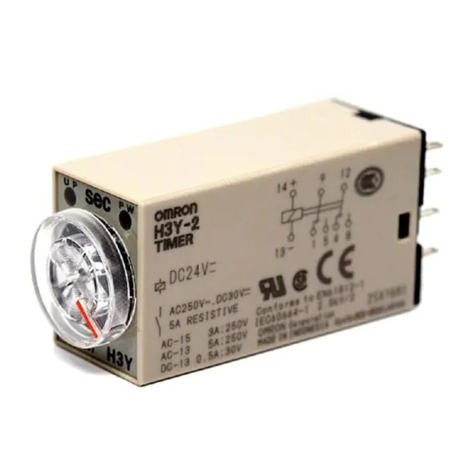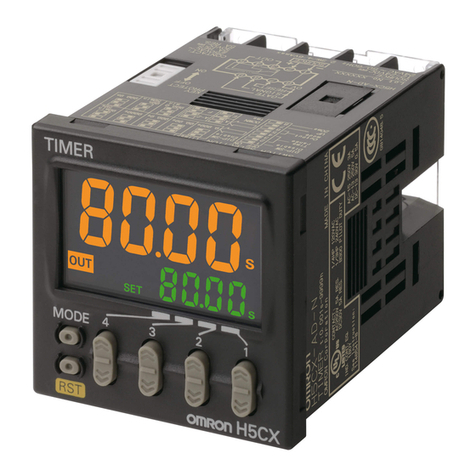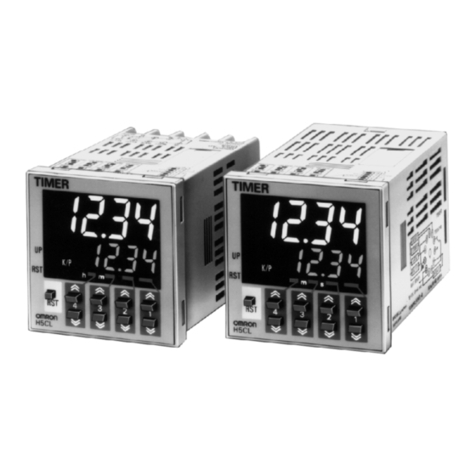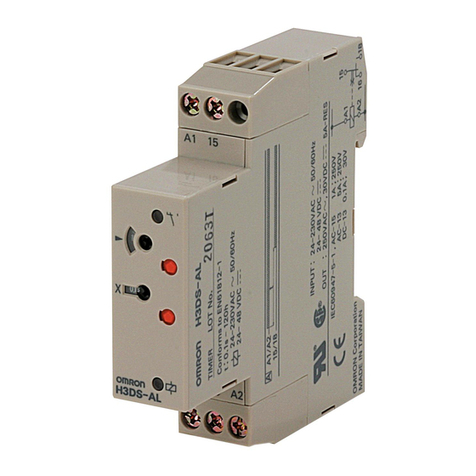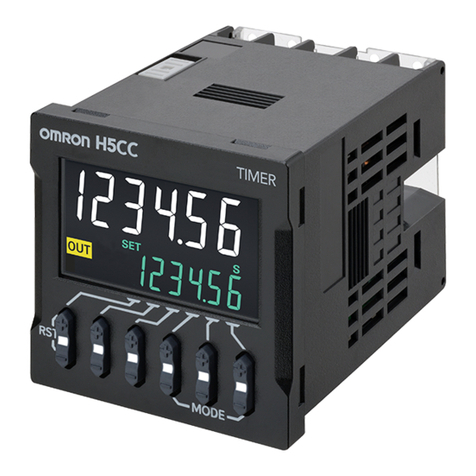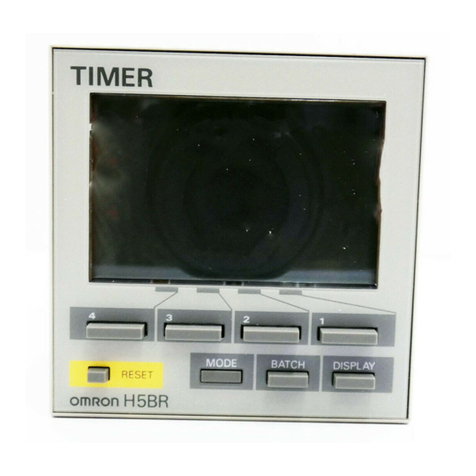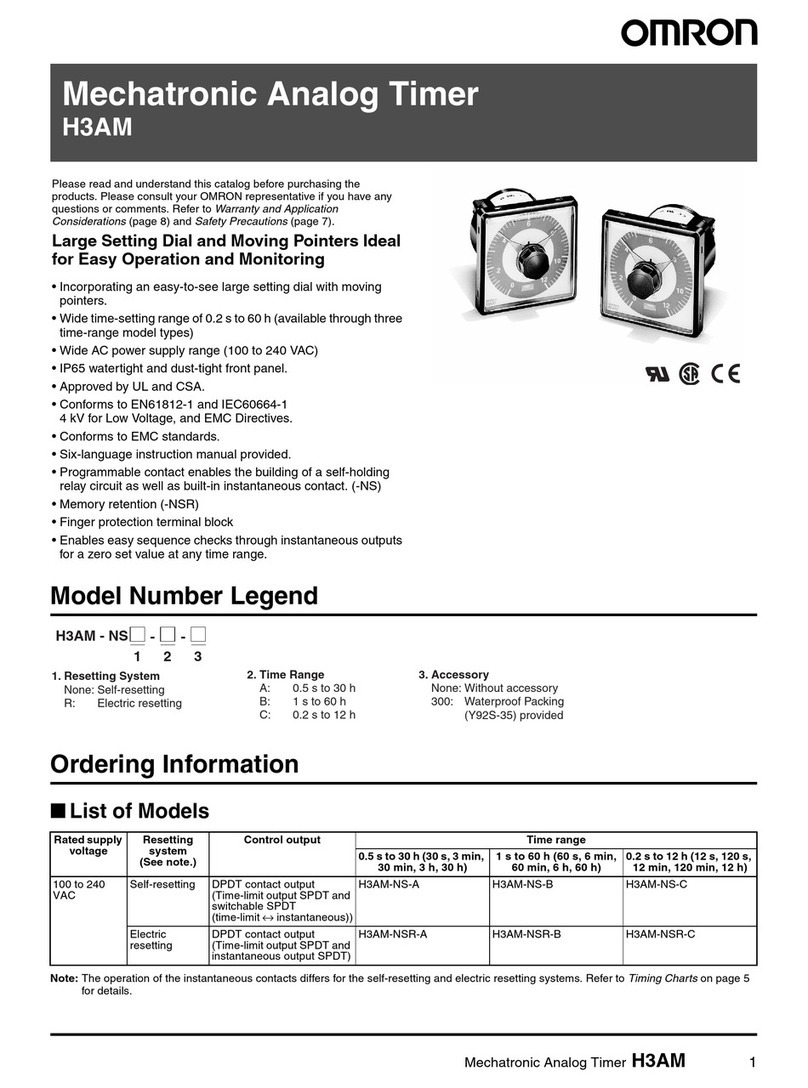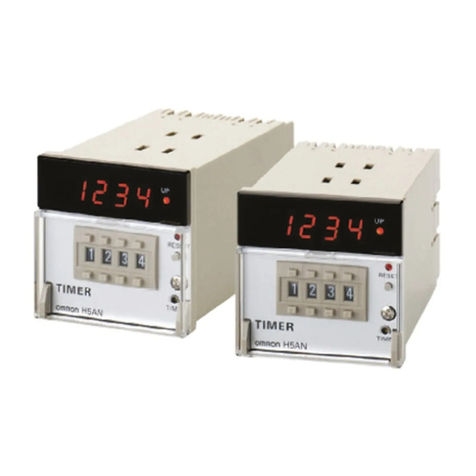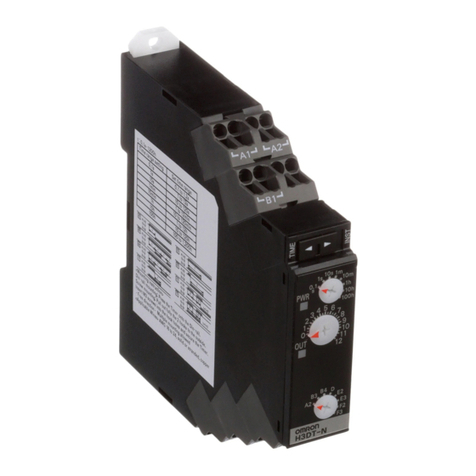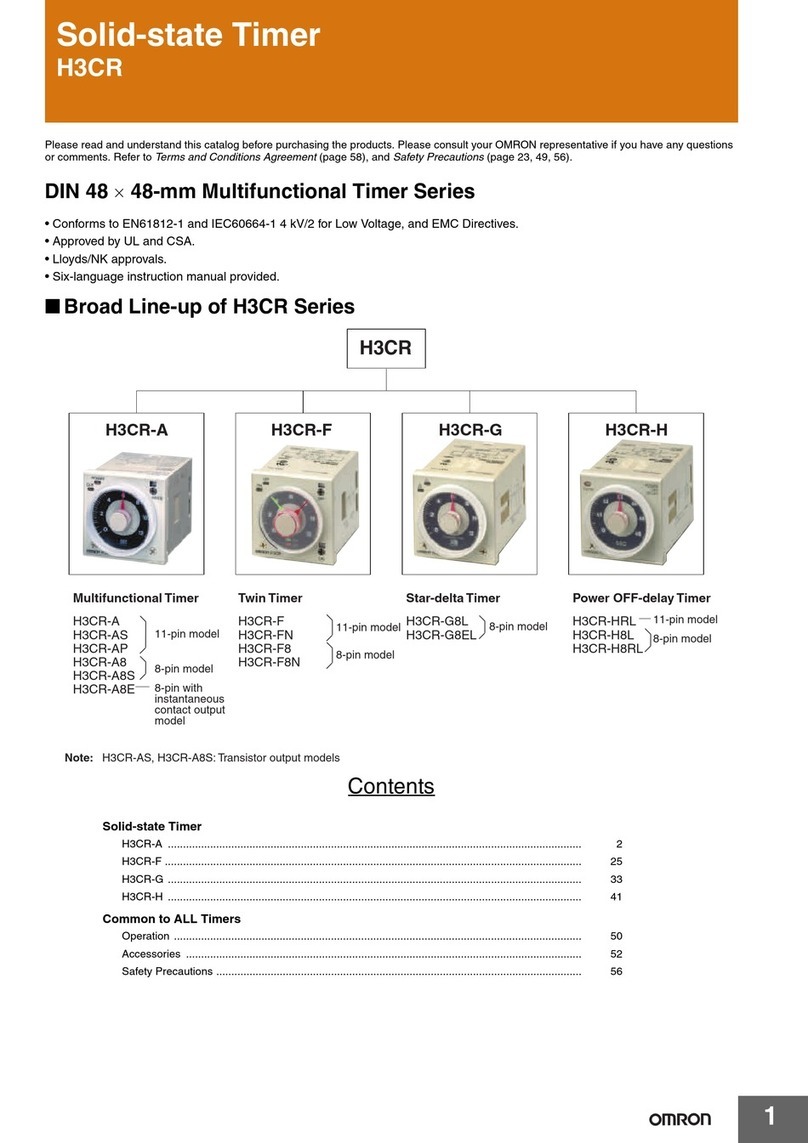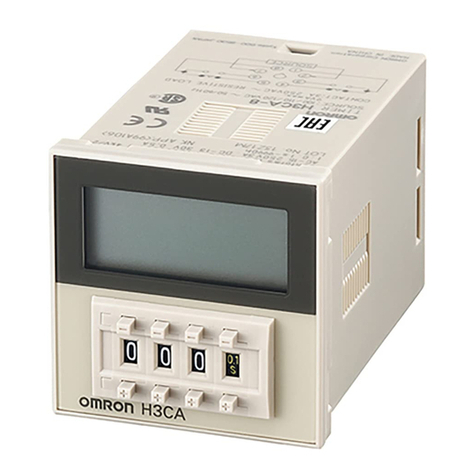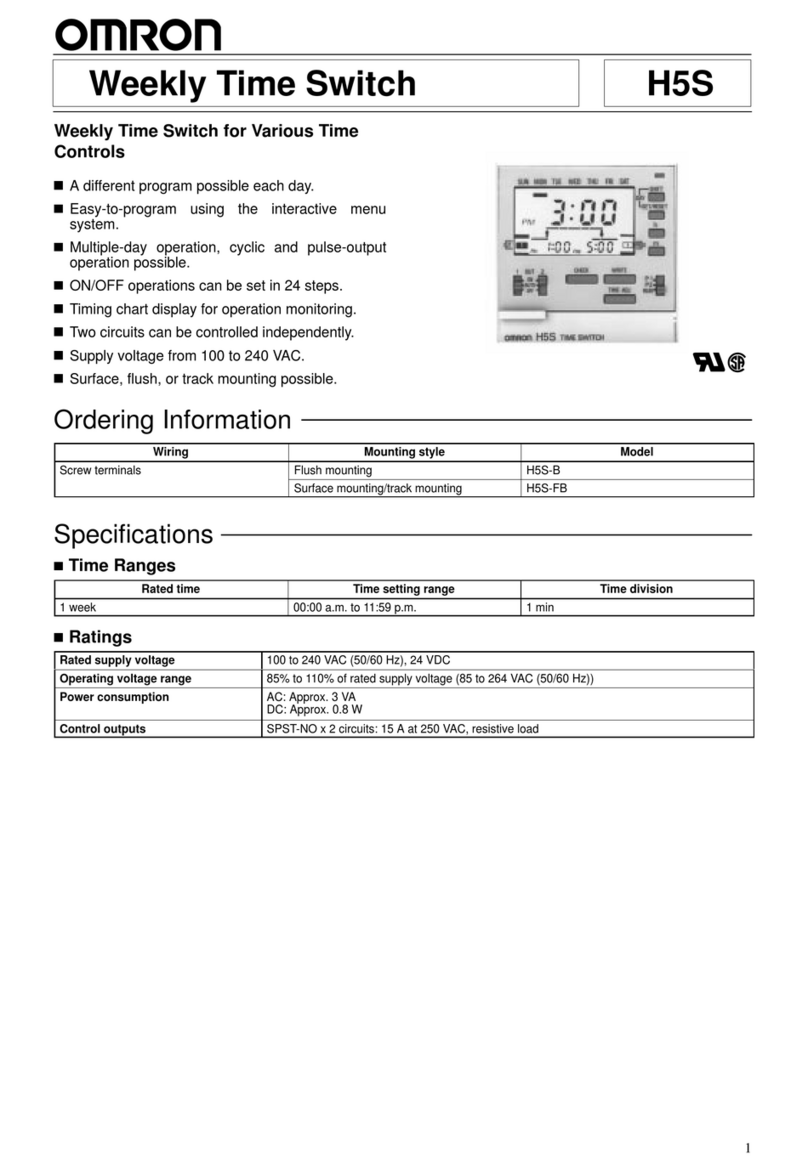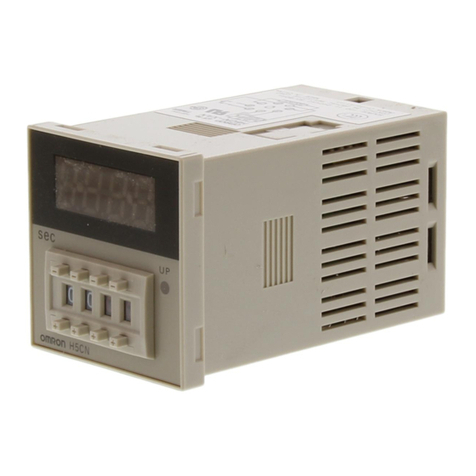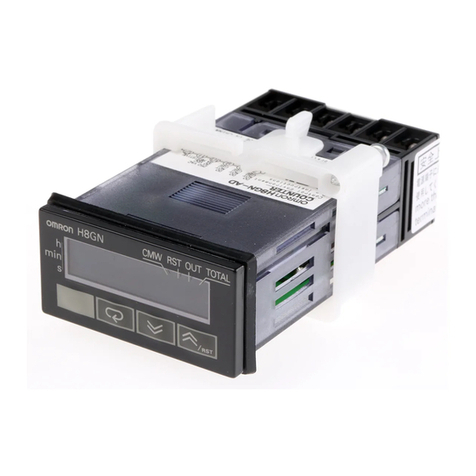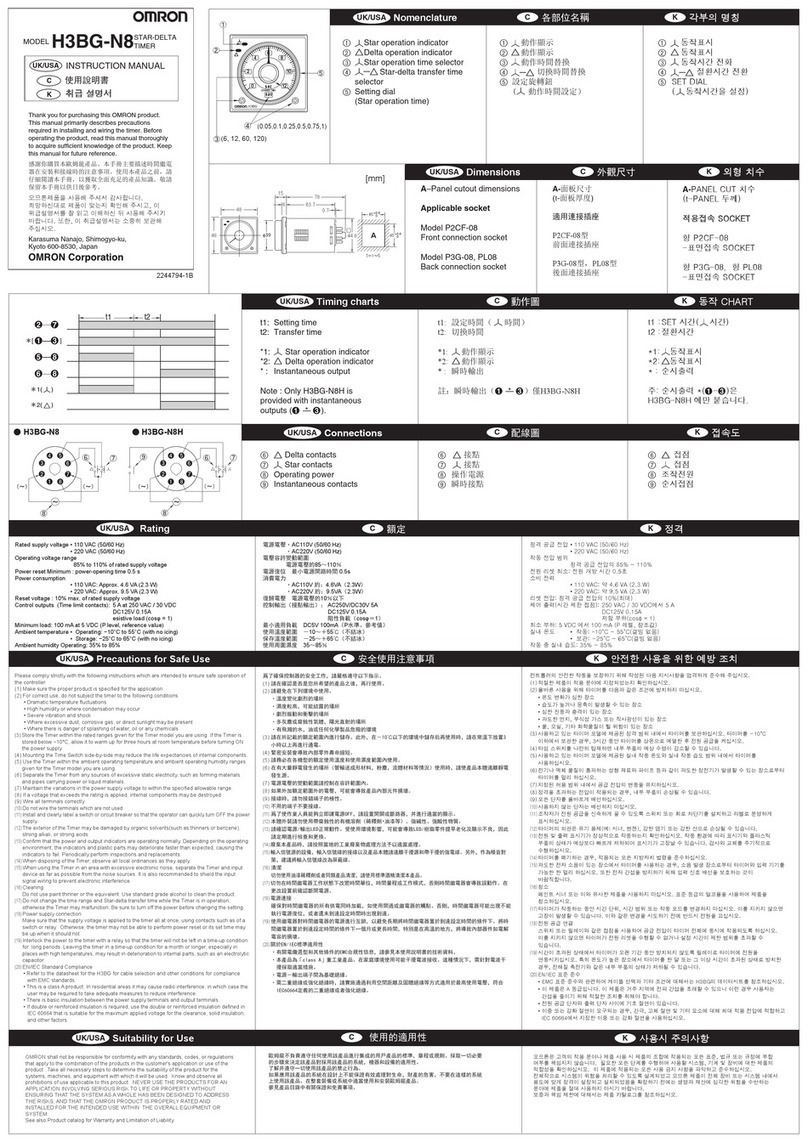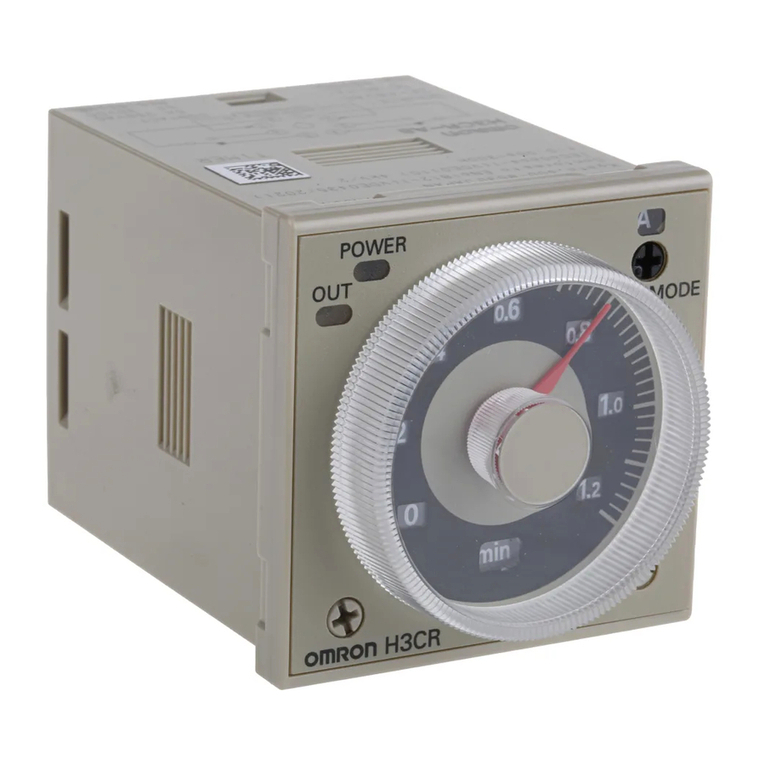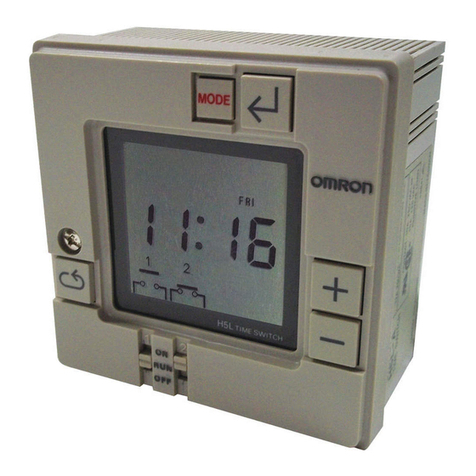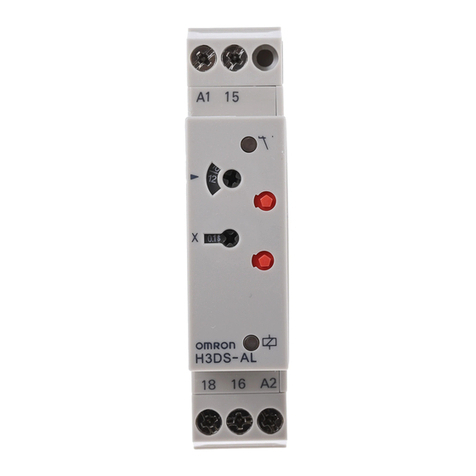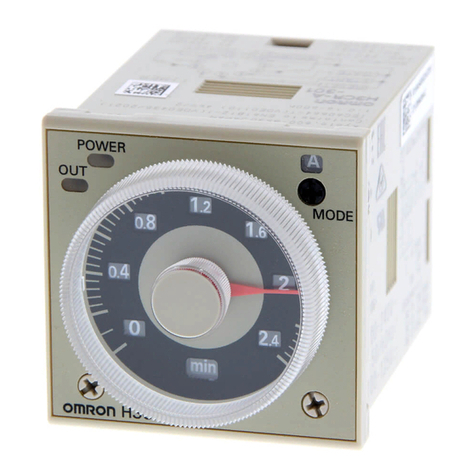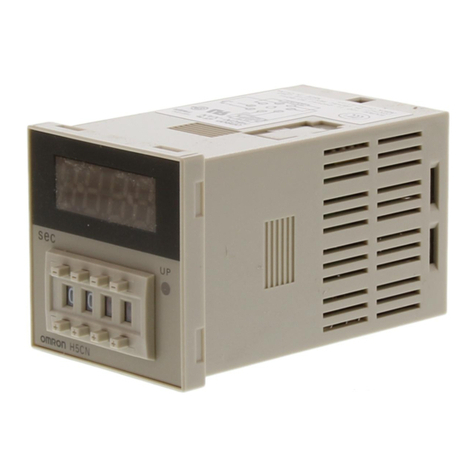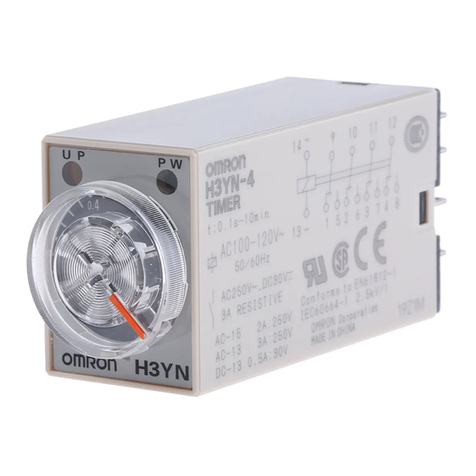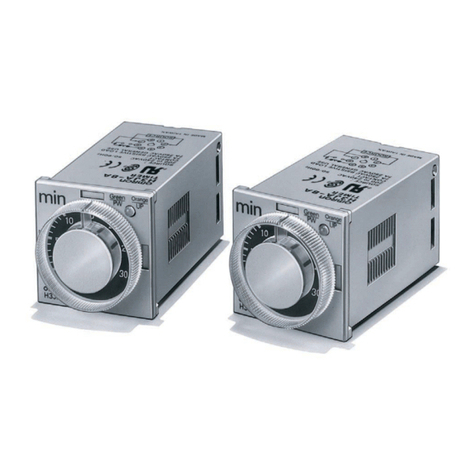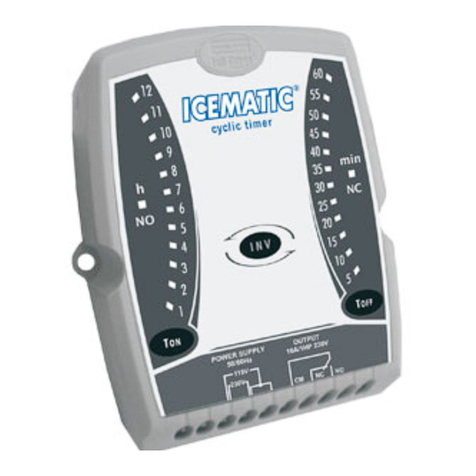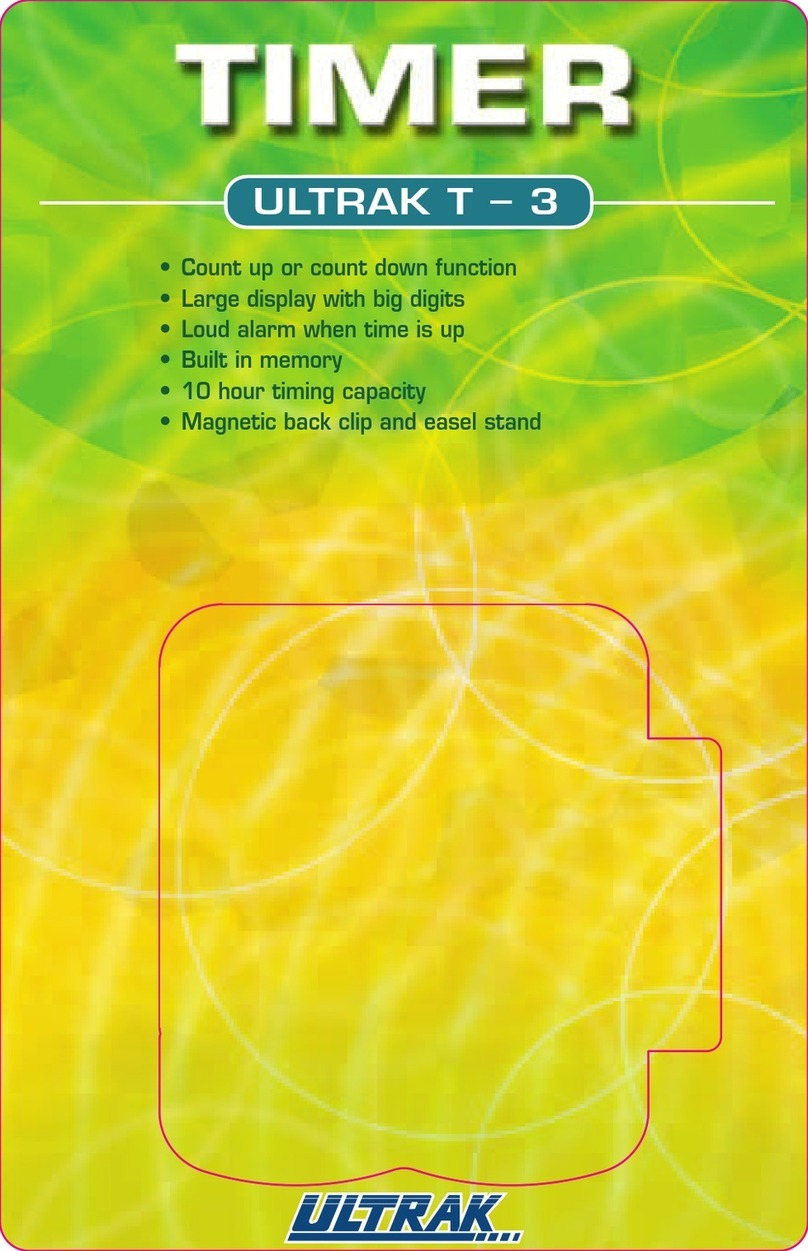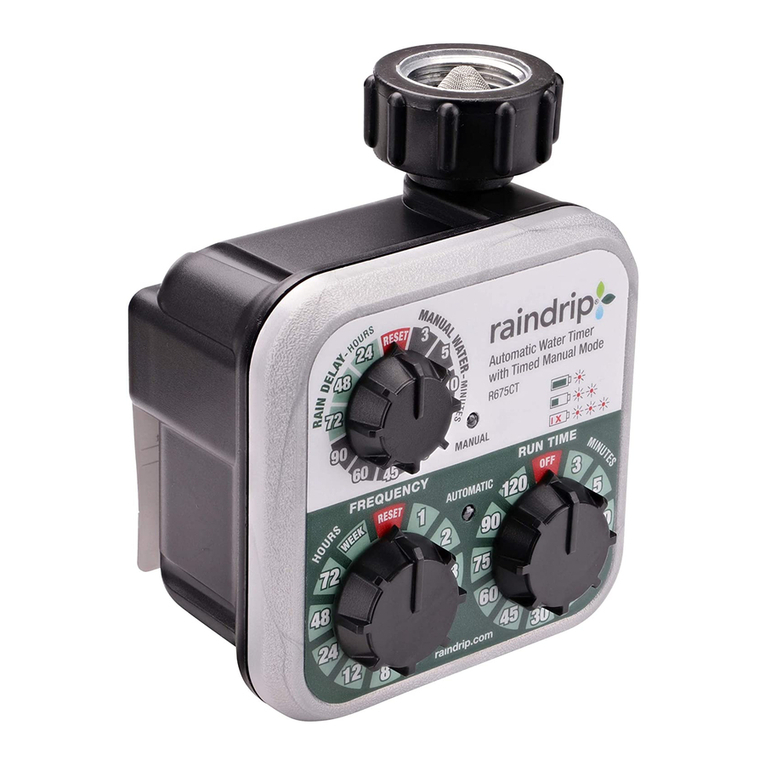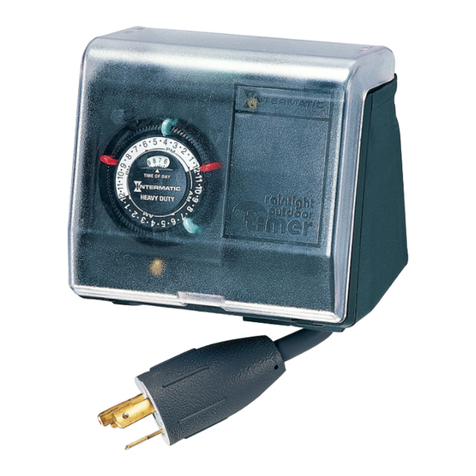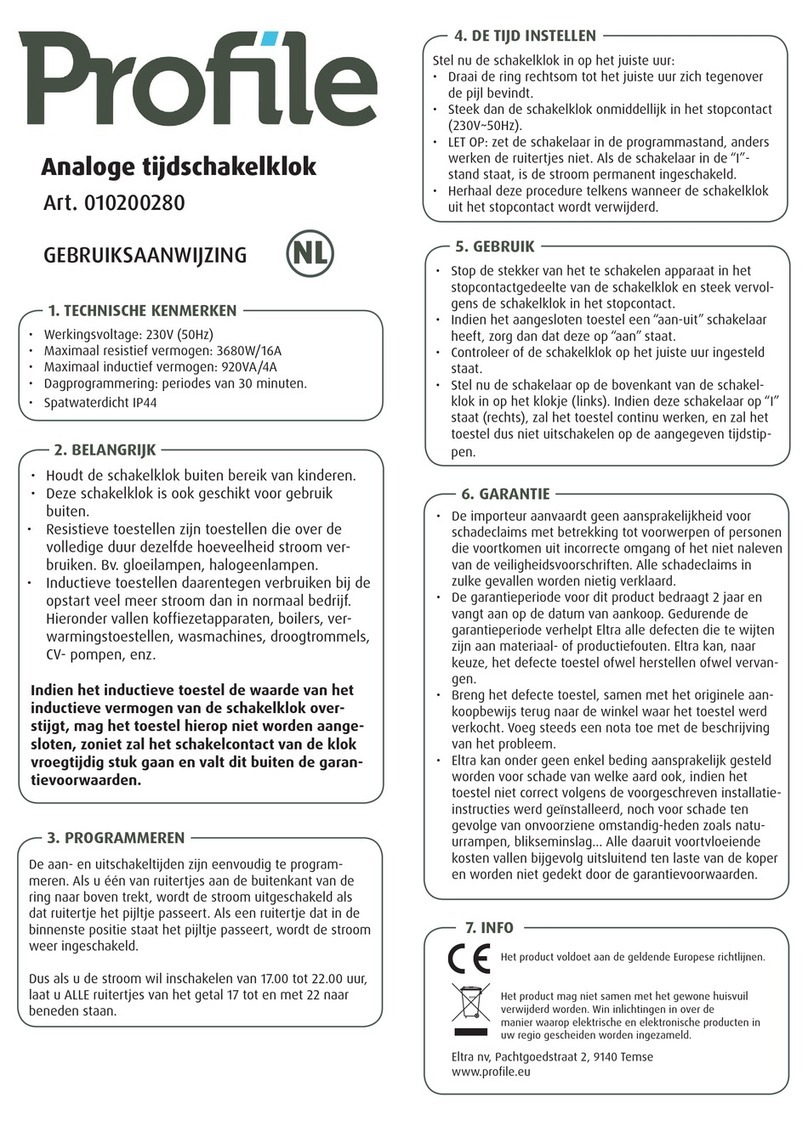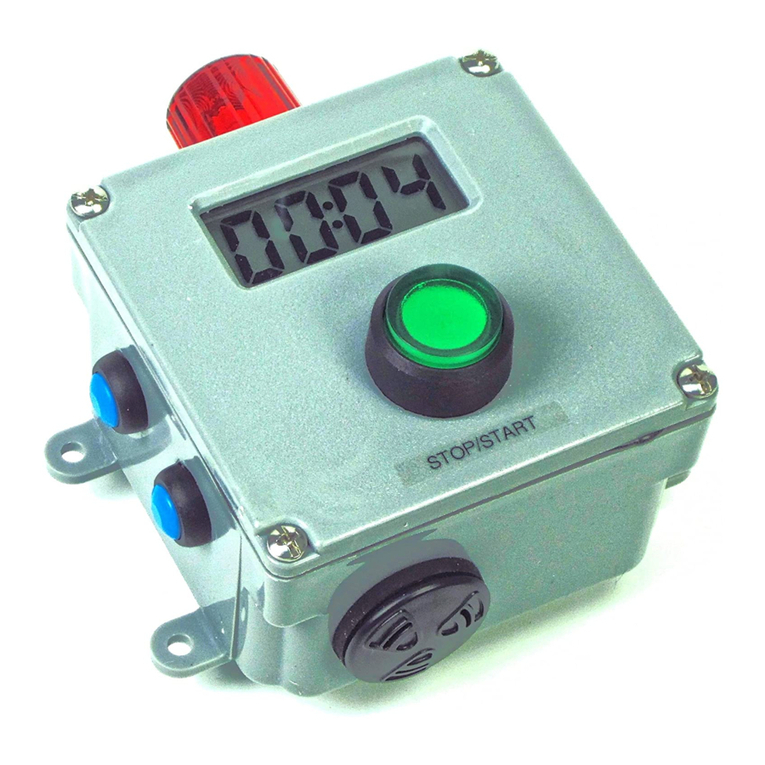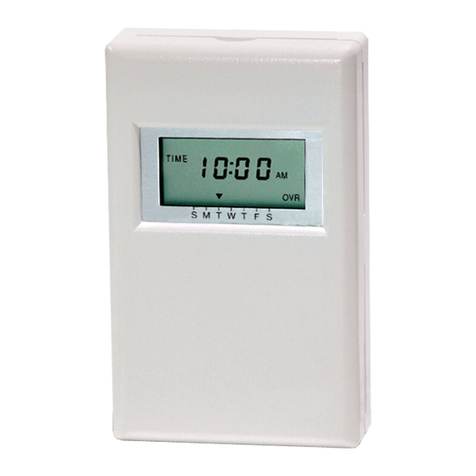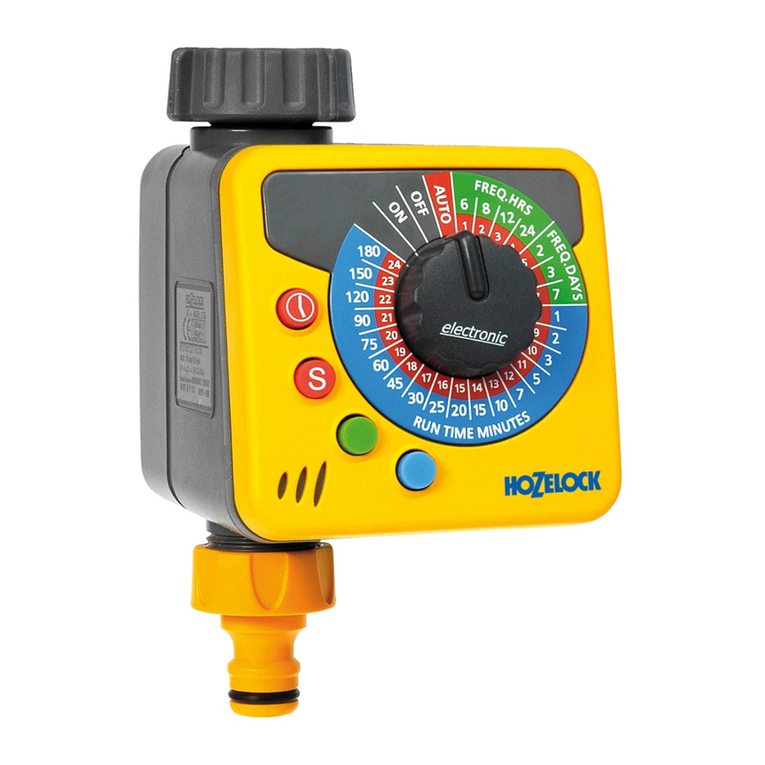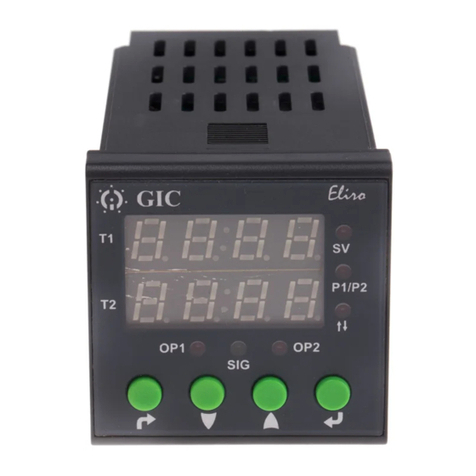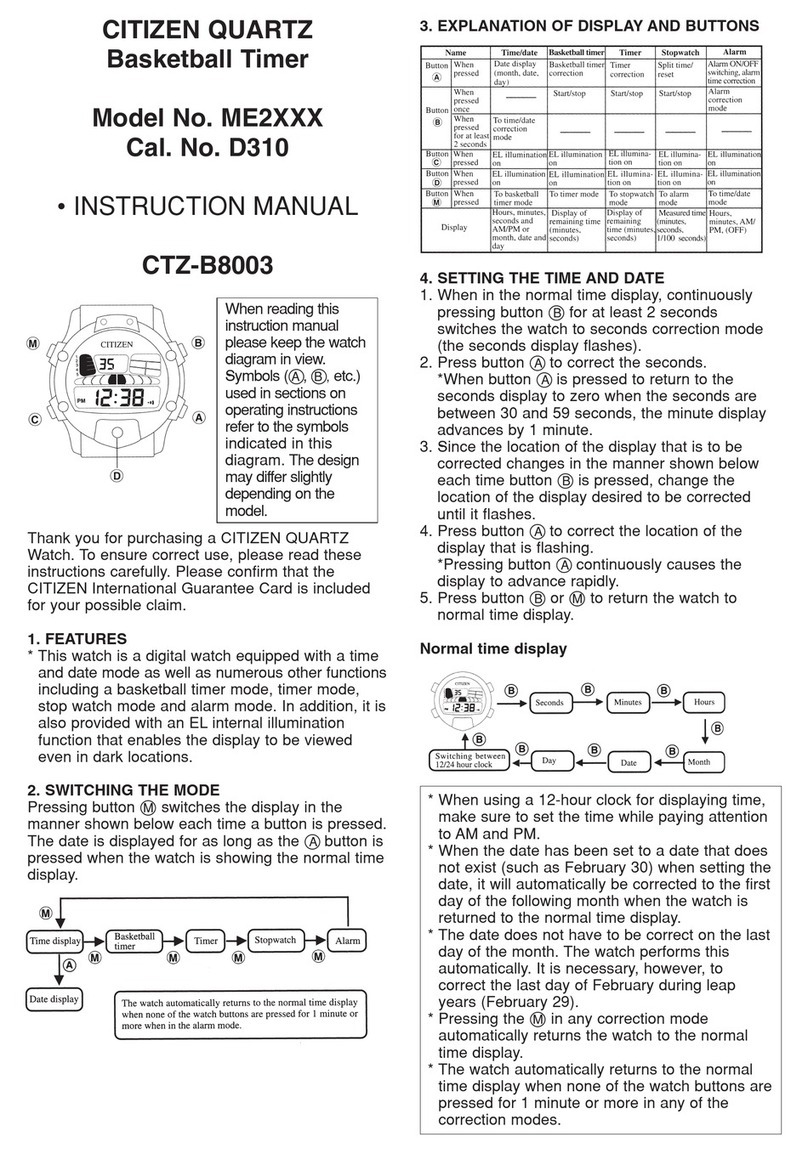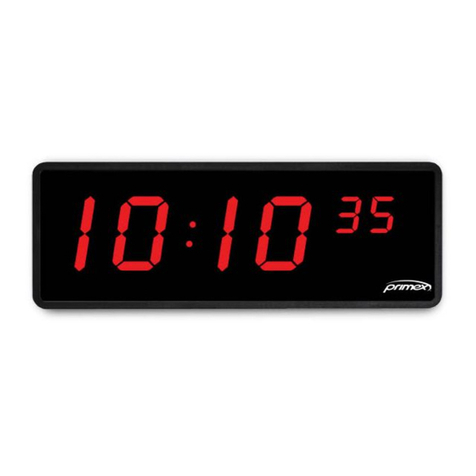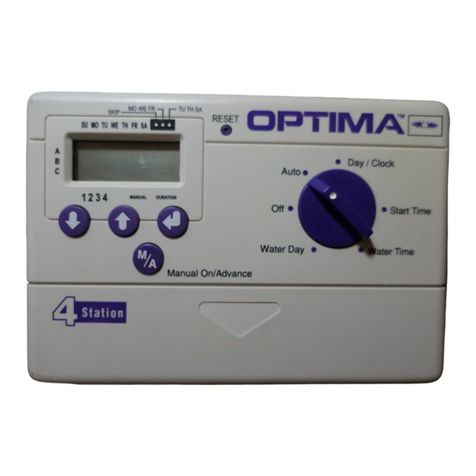G : Entrée porte
Pour arréter la temporisation.
Ouvrez la bovne 5 lorsqu'elle n'est pas utilisée.
S :Entrée de départ
Cout-circuitez les bornes 6 et 2 pour un départ á la mise sous ten-
sion et une rimise á zéro á la coupure de tension.
R : Entrée de remise á zéro
Entrée de remise á zéro externe. Ouvrez la boune 7 lorsqu'elle n'est
pas utilisée.
⑦Tension d'alimentation
⑧Connexion du signal d'entrée (contact)
⑨Connexion des signaux d'entrée statique
G : Toreingang (Sockelkemme 5)
Hält den Zeitablauf an. Wird diese Funktion nicht benötigt, braucht
der Toreingang nicht angesch lossen werden.
S : Starteingang (Sockelklemme 6)
Bei dei Funktion Spannungsstart / Spannungsstopp muß der
Starteingang angesch lossen sein.
R : Rücksetzeingang (Sockelklemme 7)
Wird disse Funktion nicht benötigt, braucht der externe
Rücksetzeingang nicht angeschlossen werden.
⑦
Arbeitsspannung
⑧
Kontakt Eingangs Verbindung
⑨
Anschluß von Halbleitersignal-Eingängen
G : Gate input
Temporarily stops timing operation.
Open terminal twhen not used.
S : Start input (Always connect)
Short-circuit terminal y―wwith power-on start and power re-
set operation.
R : Reset input
External reset input.
Open terminal uwhen not used.
⑦Operating power
⑧Contact input signal connection
⑨Solid-state input signal connection
Model -A
-AS
H3CR
SOLID-STATETIMER
INSTRUCTION SHEET
Bedienungsanleitung
Manuel d'instructions
OMRON Corporation 11P
Bitte lesen Sie diese Betriebsanleitung
sorgfältig durch, bevor Sie mit dem Gerät
arbeiten.
Thank you for purchasing this OMRON
product. This manual primarily describes
precautions required in installing and wiring
the timer. Before operating the product ,read
this manual thoroughly to acquire sufficient
knowledge of the product. Keep this manual
for future reference.
Avant d'utiliser ce produit, veuillez, s'il
vous plait, lire attentivement ce manuel
pour vous familiariser avec le produit.
Karasuma Nanajo, Shimogyo-ku,
Kyoto 600, Japan
UK/USA
D
F
POWER
OUT
MODE
H3CR
0
5
10
15
20
25
30
min
➁
➂
➃
➄
➅
(A, B, B2, C, D, E)
(sec, min, hrs, 10h)
(1.2, 3, 12, 30)
➀
48
48 φ39
66.6
44.8
□
15
652.30.7
45
+
0.6
0
45
R0.5max.
t=1〜5
+
0.6
0
A
[mm]
―
*2(power)
t
―
―
ttttttt
*3
*1(out)
(START)
(RESET)
●H3CR-A
〜
(−)
(〜) (+)
(〜)
{
➆
GSR
{
➇
●H3CR-AS
〜
{
➆
G
SR
〜
GSR
➈
− +
− +
− +
H3CR
〜
H3CR
10
22
10
22
G.
5
S.
6
R.
7
G.
5
S.
6
R.
7
H3CR
〜
H3CR
10
22
10
22
G.
5
S.
6
R.
7
G.
5
S.
6
R.
7
H3CR
〜
10
22
G.
5
S.
6
R.
7
*1
*3 *2
10
2
5
G.
6
S.
7
R.
*4
H3CR
〜
*5
➉
+ Ry
―
*2(power)
t
―
*3 *3 *3
*1(out)
t t-a t
(START)
―
*2(power)
―
*1(out)
t
*3
(START)
―
*2(power)
t
―
*3
*1(out)
t
*3
(START)
Nomenclature
UK/USA
Bezeichnungen der Teile
Nomenclature
①Power indicator
②Output indicator
③Rated time selector
④Time unit selector
⑤Setting dial (setting time value)
⑥Operation mode selector
Note:If pointer is turned counterclockwise
until overranged, instantaneous output
will be issued. (zero point instantaneous
operation)
Dimensions
A−Panel cutout dimensions
Applicable socket
Model P2CF-11
Front connection socket
Model P3GA-11
Back connection socket
Timing charts
Connections
Mode
A.
Signal ON de-
lay operation
*1:Output indicator
*2:(power)indicator
*3:flicker
Mode B.
Signal ON
flicker, OFF
start operation
*1:Output indicator
*2:(power)indicator
*3:flicker
Mode B2.
Signal ON
flicker, ON
start operation
*1:Output indicator
*2:(power)indicator
*3:flicker
Mode
C.
Signal ON•OFF
delay operation
*1:Output indicator
*2:(power)indicator
*3:flicker
Mode
D.
Signal OFF
delay
operation
*1:Output indicator
*2:(power)indicator
*3:flicker
Mode
E.
Signal ON
interval
operation
*1:Output indicator
*2:(power)indicator
*3:flicker
⑬
①
Spannungsversorgungsanzeige
②
Ausgangsanzeige
③
Zeitbereichsschalter
④
Zeiteinheitwahlschalter
⑤
Einstellscheibe (eigestellte Zeitdauer)
⑥
Betriebsartwahlschalter
Hinweis: Sofortausgang(Sofortbetrieb)
kann durch Drehung der Einstellscheibe
auf 0 eigestellt werden.
①Voyant d'alimentation en courant
②Voyant de puissance de sortrie
③Sélecteur de temps nominal
④Sélecteur de temps
⑤Cadran de réglage (réglage du temps)
⑥Sélecteur du mode de fonctionnement
Remarque :Use sortie instantanée est pos-
sible en plaçant le cadran sur le réglage 0
(mode sortie instantanée).
Abmessungen
Dimensions
A−
Frontplattenausschnitt
Verwendbare Sockel
P2CF-11
Frontseitige Klemmen
P3GA-11
Rückseitige Klemmen
A−Découpe du panneau
Socle
Modèle P2CF-11
Socle à connexion avant
Modèle P3GA-11
Socle à connexion arrière
Zeitablauf
Tableaux de minutage
Anschlußanordnung
Brochage
Bitte folgen Sie genau den folgenden Hinweisen.
Die gewährleisten eine sichere Funktion des Zeitrelais.
(1) Setzen Sie das Zeitrelais nicht unter den folgenden
Bedingungen ein :
• Erhebliche Temperaturschwankungen
• Hohe Luftfeuchtigkeit oder wenn Kondensation entstehen könnte
• Vermeiden Sie starke Vibration oder Schock
• Korrosieves Gas oder staubige Umgebung
• Bei plätscherndem Wasser, Öl oder irgendwelche Chemikalien
• Wenn in der Umgebung explosive oder entflammbare Gase sind
(2) Spannungsversorgung
Stellen Sie sicher, daß die Spannungsversorgung innerhalb des angegebenen
Bereiches liegt.
(3) Handhabung
Demontieren, modifizieren und reparieren Sie bitte niemals das Gerät.
(4)
Stellen Sie sicher, daß das Produkt den Anforderungen Ihrer
Anwendung entspricht.
(5)
Schließen Sie die Drähte mit der richtigen Polarität an.
(6)
Montieren Sie das Zeitrelais und die Eingangsverdrahtungen soweit wie möglich
von elektrischen Störungen oder Starkstromschaltgeräten entfernt.
(7)
Verwenden Sie das Zeitrelais nur innerhalb des Temperaturbereiches von -10 bis
+55 °C und bei einer relativen Luftfeuchtigkeit zwischen 35 und 85%.
(8) Reinigung
Verwenden Sie keine Verdünnung für Lacke o.ä., sondern nur Reinigungsalkohole.
(9)
Ändern Sie niemals die Zeiteinheit, den Zeitbereich oder den Arbeitsmodus
während das Gerät arbeitet, andernfalls wird eine Fehlfunktion daraus
resultieren. Stellen Sie sicher, daß bei derartigen Änderungen die Netzspannung
abgeschaltet ist.
(10) Leitungsanschluß für Ein-/Ausgang
Falls Sie einen Kontakt oder einen Transistor als externes Eingangssignal für das
Zeitrelais benutzen, beachten Sie die folgenden Punkte um Kurzschlüsse durch
transformatorlose Netzteile zu vermeiden.
⑩Bei gleichzeitigem Signaleingang von einern Eigangsanschluß oder
Eingangstransistor an mehr als ein Zeitrelais müssen die Phasen der
Stromquellen übereinstimmen.( *1) Falls die Stromquellen nicht gleichphasig
sind, wird Kurzschlußstorm erzeugt.
⑪Verwenden Sie einen Netztransformator( *2) mit voneinander isolierter Primär-
und Sekundärwicklung und ungeerdeter Sekundärwicklung als
Spannungsversorgung.( *3)
⑫Die Eingangsklemmen 5 ( Toreingang), 6 (Starteingang) oder 7 (Rücksetzeingang)
verwenden die Netzklemme 2 als gemeinsamen Punkt (com.) und müssen deshalb
mittels Kurzschlußbrücke mit der Klemme 2 verbunden werden.
Spannung sollte nur zwischen den Klemmen 10 und 2 angelegt werden. Schließen
Sie niemals Spannung an andere Klemmen an, und verbinden Sie niemals die
Klemmen 5, 6, oder 7 mit der Klemme 10 oder irgendeiner anderen als der
Klemme 2. Andernfalls wird der interne Schaltkreis oder das Zeitrelais zerstört.
*5Klemmen Sie kein Relais oder eine induktive Last zwischen die Eingangsklemmen
( Klemmen 10 und 2 ) , der interne Schaltkreis des Zeitrelais könnte durch die
Versorgungsspannung zerstört werden.
(11) Anschluß der Netzspannung
Verwenden Sie eine Gleichspannungsversorgung mit einer Restwelligkeit von 20%
oder weniger und eine mittlere Spannung, die innerhalb des angegebenen
Bereiches für die Betriebsspannung des Zeitrelais liegt.
Stellen Sie sicher, daß die Spannung über die ganze Zeit am Zeitrelais ansteht.
Verwenden Sie Kontakte, wie z.B. ein Relais.
Andernfalls kann das Zeitrelais nicht ordentlich arbeiten.
Es könnte z.B. die Netzrückstellung oder der Endzeitpunkt geschaltet werden,
obwohl die Zeit noch nicht abgelaufen ist.
(12)
Überschreiten Sie bitte niemals die auf dem Zeitrelais angegebene Nennspannung.
Wenn eine andere Spannung als die angegebene Nennspannung angelegt wird,
werden die internen Komponenten beschädigt.
(13)
Bitte beachten Sie die nebenstehende Zeichnung.( ⑬)
Ve rknüpfen Sie das Netz über ein Relais mit dem Zeitrelais, so daß es niemals
über eine längere Zeit (ein Monat oder länger) in der Funktion „Zeit abgelaufen”
stehen bleibt.
Es könnten sonst Bauteile wie z.B. Elektrolytkondensatoren vorzeitig zerstört
werden.
Veuillez suivre précisément les instructions suivantes afin d'utiliser
correctement la minuterie.
(1) Pour une bonne utilisation de la minuterie, veuillez éviter les condi-
tions suivantes:
• Les fortes variations de température
• Les zones à forte humidité où de la condensation pourrait se former
• Les chocs est les vibrations trop importantes.
• Les environnement poussiéreux ou contenant des gaz corrosifs,
• Les endroits où il y a des risques d'éclaboussures d'eau, d'huile ou
autres produits chimiques.
• Les ambiances explosives ou avec des gaz fortement inflammables.
(2) Alimantation
Vérifier que la tension d’alimentation correspond à celle du produit.
(3) Manipulations
Ne jamais désassembler, modifier ou réparer ce produit.
(4) Assurez vous que le produit correspond à votre application.
(5) Connectez les bornes avec la bonne polarité
(6) Placez la minuterie et ses éléments de commande, à distance de toute
source de perturbation et d'alimentation haute tension.
(7) Utilisez la minuterie avec une température ambiante entre -10°et
55°et une humidité relative entre 35 et 85%.
(8) Nettoyage
N'utilisez pas des solvants de peinture ou équivalents. Utilisez des
produits à base d'alcool.
(9) Ne changez pas le temps, la gamme de temps ou la fonction alors que
la minuterie est en fonctionnement. Sinon un dysfonctionnement
pourrait survenir. Soyez sûr d’être en position off.
(10)Connexions des E/S:
Lors de la connexion de sorties contacts ou transistors sur le signal
d'entrée de la minuterie faites attention aux points suivants pour
éviter tout court-circuit sans transfomateur d'alimentation.
⑩Lors de l'entrée simultanée de signaux à plusieurs minuteries à partir
du même contact ou transistor, les phases des alimentations doivent
correspondre. Si elles ne sont pas en phase, du courant de court-
circuit sera produit.( *1)
⑪Utiliser un transformateur( *2) d'alimentation avec isolement
mutuel de le bobine primaire et secondaire et avec le bobine secondair
non mise à la terre comme source d'alimentation de l'appareil
d'entrée.( *3)
⑫Les bornes d'entrées 5 (Entrée porte), 6 (Entrée départ), 7 (Remise à
zéro), utilisent la borne d'alimentation 2 comme borne de commun et
par conséquent doivent être liée à la borne du commun 2. La tension
ne peut être appliquée qu'entre les bornes 10 et 2. N'appliquez pas
de tension à toute autre borne, et ne connectez pas les bornes 5, 6, ou
7 à la borne 10, ou toute autre borne que la borne 2. Sinon le circuit
intérieur de la minuterie pourrait être endommagé.
*5Ne connectez pas un relais ou toute autre charge inductive en ligne
avec les entrées d'alimentations (bornes 2 et 10), ou le circuit intérieur
de la minuterie pourrait être endommagé.
(11) Connexion de l'alimentation
Utilisez une alimentation Vc.c. avec un facteur d'ondulation inférieur
à 20% délivrant la tension nominale marquée sur le produit.
Assurez vous d’alimenter la minuterie d’un coup en utilisant des con-
tacts tels que des relais ou des interrupteurs.
Sinon, la fonction remise à zéro ou le temps réglé pourrait être altérés.
(12)Veuillez ne pas dépasser la tension nominale indiquée sur la
minuterie. Si une tension supérieure à celle indiquée est appliquée,
le circuit interne du composant risque d'être endommagé.
(13)Ve uillez vous référer au schéma de gauche.( ⑬)Interfacez la puis-
sance et la minuterie avec un relais. Ainsi la minuterie ne restera
pas durant une longue période en position temporisation finie. Le
maintien dans cette position durant un mois ou plus pourrait,
spécialement dans une ambiance avec une haute température,
détériorer des composants internes tel que les condensateurs.
X/b T/a X/a
TX
x : Relay(ModelMY)
0696882-6A
D F
F
Please comply strictly with the following instructions which are intended
to ensure safe operation of the controller.
(1) For correct use, do not subject the timer to the following condi-
tions.
• Dramatic temperature fluctuations
• High humidity or where condensation may occur
• Severe vibration and shock
• Corrosive gas or dusty environments
• Where there is danger of splashing of water, oil or any chemicals
• Where explosive or flammable gases may be present
(2) Load power supply
Make sure that the load power supply is within the rating.
(3) Handling
Never disassemble, modify or repair the product.
(4) Make sure the proper product is specified for the application.
(5) Wire terminals with correct polarity.
(6) Locate the timer, input devices and input signal wiring as far as
possible from noise sources and conductors carrying high voltage.
(7) Be sure to use the Timer at ambient temperature of -10 to 55 °C and
ambient humidity (relative humidity) of 35 to 85 %.
(8) Cleaning
Do not use paint thinner or the equivalent. Use standard grade alco-
hol to clean the product.
(9) Do not change the time unit, time range or operation mode while the
Timer is in operation, otherwise malfunction could result. Be sure to
turn off the power before making such changes.
(10)I/O Line connection
When connecting the contact or transistor for external input signal
to the input terminals of the timer, pay attention to the following
points to prevent short-circuiting of the transformerless power sup-
ply.
⑩When simultaneously inputting signals to more than one timer from
the same input contact or transistor, the phases of the power sup-
plies must agree.(*1) If the power supplies are not in phase, short-
circuit current will be generated.
⑪For the power supply of an input device, use an isolation transformer(
*2), of which the primary and secondary windings are mutually
isolated and the secondary winding is not grounded. ( *3)
⑫The appropriate input terminal 5 (Gate input), 6 (Start input) or 7
(Reset input) uses power supply terminal 2 as a common terminal
and should therefore be connected by short-circuit to common termi-
nal 2. Voltage should be applied only across terminals 10 and 2. Do
not apply voltage to any other terminals, and do not connect termi-
nals 5, 6, or 7 to terminal 10, or to any terminal other than terminal
2. Otherwise the internal circuit of the timer may be damaged.
*5Do not connect a relay or other inductive load across the input sup-
ply points (terminals 2 and 10), or the internal circuit of the timer
may be damaged due to applied supply voltage.
(11) Power supply connection
Use a DC power supply having a ripple factor of 20% or less and
supplying a mean voltage that is within the rated operating voltage
marked on the timer.
Make sure that the supply voltage is applied to the timer all at once,
using contacts such as of a switch or relay. Otherwise, the timer may
not be able to perform power reset or its set time may be up when it
should not.
(12)Please do not exceed the voltage rating marked on the timer.
If voltage other than the rated voltage is applied, the internal com-
ponents may be damaged.
(13)Please refer to the diagram shown on the left.(⑬)Interlock the power
to the timer with a relay so that the timer will not be left in a time-up
condition for long periods. Leaving the timer in a time-up condition
for a month or longer, especially in places with high temperatures,
may result in deterioration to internal parts, such as an electrolytic
capacitor.
UK/USA
D F
―
*2(power)
t
―
―
*3
*1(out)
(START)
(RESET)
Modus
A.
Zeitverzögerter
Betrieb des EIN-
Signals
*
1
:
Ausgangsanzeige
*
2
:
Netzanzeige
*
3
:
blinkend
Modus
B.
Signal EIN
blinkend
(Aus-Start-
Betrieb)
*
1
:
Ausgangsanzeige
*
2
:
Netzanzeige
*
3
:
blinkend
Modus B2.
EIN-Signal
blinkend,
EIN
Betriebsbeginn
*
1
:
Ausgangsanzeige
*
2
:
Netzanzeige
*
3
:
blinkend
Mode
A.
Signal ON,
déclenchement
retardé
*1:Voyant de sortie
*2:Voyant d'alimentation
*3:clignotant
Mode
B.
Signal ON
clignote
(déclenchement
annulé)
*1:Voyant de sortie
*2:Voyant d'alimentation
*3:clignotant
Mode B2.
Signal ON
clignote,
déclenchement
*1:Voyant de sortie
*2:Voyant d'alimentation
*3:clignotant
Modus
C.
Zeitverzögerter
Betrieb des EIN/AUS-
Signals
*
1
:
Ausgangsanzeige
*
2
:
Netzanzeige
*
3
:
blinkend
Modus
D.
Zeitverzögerter
Betrieb des
AUS-Signals
*
1
:
Ausgangsanzeige
*
2
:
Netzanzeige
*
3
:
blinkend
Modus
E.
Intervallbetrieb
des EIN-
Signals
*
1
:
Ausgangsanzeige
*
2
:
Netzanzeige
*
3
:
blinkend
Mode
C.
Signal ON/OFF
déclenchement
retardé
*1:Voyant de sortie
*2:Voyant d'alimentation
*3:clignotant
Mode D.
Signal OFF
déclenchement
retardé
*1:Voyant de sortie
*2:Voyant d'alimentation
*3:clignotant
Mode
E.
Signal ON
fonctionnement
intermittent
*1:Voyant de sortie
*2:Voyant d'alimentation
*3:clignotant
―
*2(power)
t
―
―
ttttttt
*3
*1(out)
(START)
(RESET)
When using the product for critical applications such as those listed below, please
be sure to maintain strict adherence to the limits of product ratings and functions.
These controllers are not intended for use as safety and limiting devices.
qFor use at any condition or environment not described in the manual.
wFor nuclear power control, railway, aircraft, vehicle, incinerator, medical
equipment, entertainment equipment, etc...
eWhere death or serious property damage is possible or where extensive safety
precautions are required.
Vorkehrungen beim Gebrauch des Produktes
Wenn Sie den Sensor in schwierigen Applikationen, wie z. B. den unten aufgeführten
verwenden wollen, dann stellen Sie bitte sicher, dass Sie sich dabei in den Grenzen der
Produktklasse und dessen Funktionen bewegen. Diese Sensoren sind nicht für
Sicherheits-oder Endabschaltungs-Aufgaben geeignet.
q
Für Anwendungen in jeglicher Umgebung oder Zustand, der nicht im Handbuch
beschrieben wird.
w
Für Anwendungen im Bereich: Regelung von Kernkraft, Schienenfahrzeuge, Luft-
fahrzeuge, Fahrzeuge, Verbrennungsöfen, medizinische Geräte, Zubehör der Unter-
haltungstechnik, etc. ...
e
Wo Tod oder ernsthafte Sachschäden möglich sind, oder umfangreiche Sicherheits-
maßnahmen erforderlich sind.
Lors de l'utilisation du produit dans les applications citées ci-après, veuillez
respecter les limites de fonctionnement du produit:
qPour toute utilisation non prévue dans ce manuel
wPour les applications de contrôle nucléaire, chemins de fer, véhicules, médi-
cal, etc...
eEn cas de risque de blessures importantes, voire de danger de mort: Dans ce
cas, des précautions particulières sont à prendre !
Precautions in using the product Précautions d'utilisation du produit
UK/USA
DF
OMRON ELECTRONICS.INC.
Phone: 1-800-55-OMRON
OMRON CANADA INC.
Phone: 1-416-286-6465
Phone: 1-514-636-6676 (French Language)
Contact address
Kontakt Adresse
EUROPEAN H.Q.
OMRON EUROPE B.V.
Phone: 31-23-5681300
GERMANY
OMRON ELECTRONICS G.m.b.H.
Phone: 49-2103-203-3
Adresse du contact
EUROPEAN H.Q.
OMRON EUROPE B.V.
Phone: 31-23-5681300
FRANCE
OMRON ELECTRONICS S.a.r.l
Phone: 33-1-49747000
F
